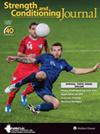旨在提高头顶运动员投球速度的核心运动训练计划的有效性:系统回顾
IF 3
4区 医学
Q2 SPORT SCIENCES
引用次数: 0
摘要
在头顶投掷中,核心肌肉在从躯干到手臂的动量传递中起作用。然而,评估各种核心运动项目对核心肌肉功能和投球速度的影响的研究得出了不同的结果。本系统综述的目的是综合这些训练方案对投球速度和躯干肌肉功能的影响,基于训练方案的重点。检索于2020年11月24日使用MEDLINE进行,并于2022年4月27日更新。如果训练是针对头顶投掷运动员,针对核心肌肉组织,并且至少有一个对照组,则纳入文章。在共检索到的875篇文章中,选择11篇进行分析。综合证据表明:(a)常用的脊柱稳定训练可以提高躯干肌肉耐力和等长肌力,但不能提高投球速度;(b)在吊索悬挂系统上进行的高级脊柱稳定练习可以提高投球速度;(c)躯干增强训练使用实心球可以提高躯干旋转力量,力量和投球速度。更具挑战性的核心练习,包括不稳定的表面,更高的阻力和动态躯干运动,似乎是促进投球速度提高的必要条件。本文章由计算机程序翻译,如有差异,请以英文原文为准。
Effectiveness of Core Exercise Training Programs Designed to Enhance Ball-Throwing Velocity in Overhead Athletes: A Systematic Review
ABSTRACT In overhead throwing, core muscles play a role in transferring momentum from the trunk to the arm. Yet, studies evaluating various core exercise programs on core muscle function and ball-throwing velocity yield varying results. The objective of this systematic review was to synthesize the effects of these programs on ball-throwing velocity and trunk muscle function based on the focus of the training program. Searches were conducted using MEDLINE on November 24, 2020, and updated on April 27, 2022. Articles were included if the training was administered to overhead-throwing athletes, targeted the core musculature, and had at least 1 comparison group. Of a total of 875 articles retrieved, 11 were selected for analysis. The synthesis of evidence suggests that (a) commonly used spinal stabilization exercises may improve trunk muscle endurance and isometric strength, but not ball-throwing velocity; (b) advanced spinal stabilization exercises performed on a sling suspension system can improve ball-throwing velocity; and (c) trunk plyometrics using medicine balls can improve trunk rotational strength, power, and ball-throwing velocity. More challenging core exercises that incorporate unstable surfaces, higher resistance, and dynamic trunk movement seem necessary to promote improvement in ball-throwing velocity.
求助全文
通过发布文献求助,成功后即可免费获取论文全文。
去求助
来源期刊

Strength and Conditioning Journal
社会科学-运动科学
CiteScore
4.70
自引率
8.00%
发文量
49
审稿时长
6-12 weeks
期刊介绍:
Strength and Conditioning Journal is the professional journal for strength coaches, personal trainers, physical therapists, athletic trainers, and other health professionals working in the strength and conditioning field. The journal’s mission is to publish articles that report both the practical applications of research findings and the knowledge gained by experienced professionals.
 求助内容:
求助内容: 应助结果提醒方式:
应助结果提醒方式:


